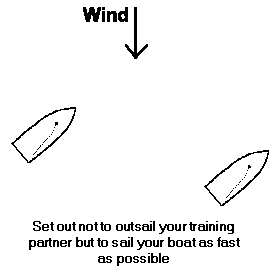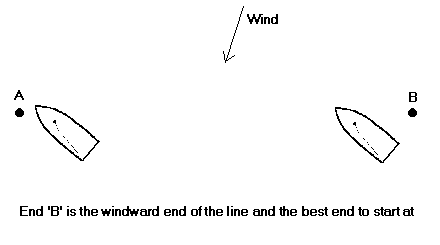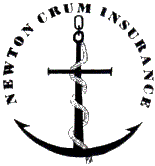
Training IIPart 2 - Tuning, Boathandling & Starting So how do we improve those aspects of our sailing that we have identified as improvement areas.
Well the first thing to realise is that we all learn in different ways, some of us are activists who will rush out and immediatly try anything that is suggested to us, rejecting it if it doesn't work first time; others are pragmatists who take on a very practical view and often decide things are not worth trying but will find other methods more to their liking; some may be theorists who will study an idea in great detail before giving it a try, and there are more, but the first message here is to do things the way you find best, not what some book or somebody said you should do. At this point lets look at some of the widely used techniques used today, always remembering that if we copy others we can reach their performance levels, but are unlikely to exceed them, however this may be enough to get you to your goals.
Two Boat Tuning One of the most widely used techinques to improve boatspeed is to go tuning with a partner.
This technique is well proven, and has been used by many top helms over the years. Time is the key, and both boats will need to devote themselves to the process, this may involve giving up some racing to train!
Boat Handling Essential to every boats speed is how quickly and efficiently the boat changes tack, manouvers, hoists the spinnaker etc; all loosly described as boathandling. Boathandling is something that can be improved by sailing alone. Lets think about what we are trying to achieve here, we want to execute our manouvers faster, we want to make less errors, and we want to maintain boatspeed as these happen, yes much of this is practice and teamwork, but lets try and speed up the process and eliminate some errors before they occur. As with the setup of the boat we can learn a lot from others, look at the top guys in your fleet, see how they tack, bear away round the top mark, hoist the kite and generally handle the boat. Take a weekend off and go to a big open, get out in a powered boat somehow, try offering your services to the rescue of race organisation, or if the racing is nearby watch from the bank. Find the best and watch, make notes, this is the standard you must aspire to. When you have seen how others do it get back to your boat, but don't go sailing just yet, rig the boat on dry land and consider the manouvers you wish to improve. Look at where you will sit or stand, what ropes need to be adjusted or sails hoisted, where will the tiller be, and how will you control it. Talk to your crew, how difficult is it for them to execute the manouver, are they having problems you don't know about, and decide on a sequence of events, who will do what and in what order, this is critical and ensures that all events run smoothly and you are not fighting each other. Now it's time to get on the water, either go out just to practice or get on the water an hour early one day. Firstly go through the sequence of events slowly, this may be difficult at first but will get everything in the right order. Now try the manouver at regular speed, go through it many times until it feels natural, you will probably find things begin to speed up, to a point this is good, but don't go too fast yet, at least until you are very confident.
Starting Estimates vary as to how important the start is within a race, generally speaking the shorter the race the more important the start becomes, but it is likely to be vital in any race. First and foremost you must have a good timing device, this may be a watch although I now believe it is possible to get a timer fixed to the mast with a large digital display. For most though a watch will do, it should have a countdown facility which you can set to differing times, digital or analogue is a matter of personal taste, and must have a strong strap, I prefer a canvas strap with a velcro fixing. Whatever you do make sure it is always visible and you do not need to pull back a cuff to see it. By the way, stating the obvious, it must be waterproof, water resistant will not do. Another point of contention is who wears the watch, this is not a question as to who is in command, as we are working as a team, but it may be easier for the crew to count the start down, leaving the helmsman to concentrate on the position and speed of the boat, the choice is yours, but do be certain as to what time signals the crew will relay to the helm. Before the start, infact before you leave the beach you should know if you are to get 10 & 5 minute, 6 & 3 minute or 3 & 1 minute signals, set the countdown of your watch to the first signal. Now my little tip is to start the watch count 3 seconds and stop, now when you hear the appropriate signal count the same 3 seconds and restart the watch, this should give you enough time to finish what you are doing and be in a position to start the countdown and be certain the watch is working. Now lets look at the concept of time and distance, we will need to practice hard at this element of the start, for some this seems to come naturally, but usually this is as a result of many hours on the water.
You do not need a startline to practice this, just a buoy, your stopwatch and some time. Firstly make some approaches to the buoy so that you will sail close hauled, within 2 feet of it at full speed. Set the watch to give yourself a 1 minute countdown and never go more than 10 lengths from the buoy, remember the secret is not to arrive at the buoy exactly at the designated time, but to arrive at full speed at the designated time, try passing just to windward and then leward of the buoy, thus simulating both ends of the line. In reality it is not possible to practice this too much, and it is something you need to do before every real start, allowing you to experience the current situation which may be affected by tides and windshadow. Continue to practice in differeing conditions, and reduce the distance you allow yourself to go away from the buoy, this will sharpen your boathandling skills, try holding the boat stationary 3-4 lengths from the buoy for 1 minute before sheeting in to pass it at the end of your countdown.
I do not intend to cover which end of the line to start at in this brief section, suffice to say that if it is a windward start unaffected by tides or wind bends, then the windward most end of the line will give the best advantage, try to use various techniques to establish which is the windward end, and whatever your judgement stick with it unless you see an obious wind change. Finally remember that maximum speed and clear air at the start will probably benefit you most.
Copyright © 1998 - 2021 |
|
 Firstly go out sailing on a quiet day in moderate conditions, set the boats up as near identical as practical and sail upwind with one boat 5-10 lengths to leward, and ahead by a similar amout of the other. Make a signal to each other and sail without tacking for at least 5 mins, or until one boat is gaining an obvious advantage. You will then need to discuss this, and if one boat has a speed advantage try to evaluate this by adjusting the slower boat to reach the faster boats speed, setting off in a similar way each time.
Firstly go out sailing on a quiet day in moderate conditions, set the boats up as near identical as practical and sail upwind with one boat 5-10 lengths to leward, and ahead by a similar amout of the other. Make a signal to each other and sail without tacking for at least 5 mins, or until one boat is gaining an obvious advantage. You will then need to discuss this, and if one boat has a speed advantage try to evaluate this by adjusting the slower boat to reach the faster boats speed, setting off in a similar way each time.
 Follow the drills in this book and become a champion! The book covers boat handling, starting races, mark rounding, tactics and finishing. Everyone who wants to improve their racing should read it. Click on the book cover to discover more details.
Follow the drills in this book and become a champion! The book covers boat handling, starting races, mark rounding, tactics and finishing. Everyone who wants to improve their racing should read it. Click on the book cover to discover more details.
